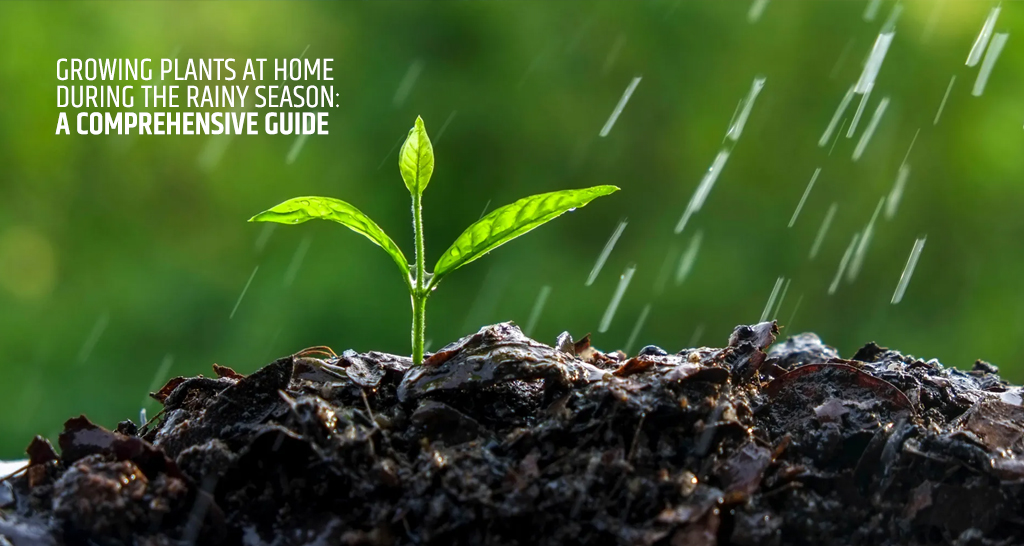The rainy season is an excellent time to start growing plants at home. With abundant rainfall and favorable conditions, this period makes it easier for plants to establish and thrive. If you want to create a lush, green space at home, start now…it is the perfect time to begin. Here is a detailed guide on why the rainy season is ideal for planting and how to make the most of it to create a vibrant garden.
Why the Rainy Season is Ideal for Plant Growth
- Consistent Water Supply: The rainy season ensures a reliable and abundant source of water, which is crucial for plant germination and early growth. Water is essential for various physiological processes such as nutrient uptake, photosynthesis, and cell expansion. Consistent moisture helps seeds swell, break their coats, and start growing.
- Optimal Soil Conditions: Rain moistens the soil, creating an ideal environment for seed germination and root growth. Moist soil prevents young seedlings from drying out and supports their establishment. Also, rain helps soften the soil, making it easier for roots to penetrate and expand.
- Enhanced Nutrients Availability: Rainwater helps dissolve nutrients in the soil, making them more accessible to plants. This nutrient availability is crucial for young plants’ healthy growth and development. The increased microbial activity during the rainy season also helps break down organic matter, enriching the soil further.
- Favorable Temperature: The rainy season usually brings warmer temperatures, which are optimal for the metabolic activities that drive plant growth. Warm, moist conditions promote faster seedling development and stronger root systems, giving plants a better start.
- Reduced Water Stress: Plants established during the rainy season experience less water stress than those planted in drier periods. With ample water available, plants can focus more on growth and development than survival.
- Improved Soil Structure: Consistent rainfall improves soil structure by facilitating the breakdown of organic matter and promoting microbial activity. A healthy soil structure is beneficial for root penetration and overall plant health.
- Natural Growth Cycles: Many plants have evolved to exploit the rainy season. Seeds often remain dormant during dry periods and germinate with the onset of rains. This synchronization with natural growth cycles ensures that plants get the best possible start.
- Increased Daylight Hours: The rainy season coincides with longer daylight hours in many regions. More sunlight means more energy for photosynthesis, which supports robust plant growth.
- Reduced Competition: The rainy season signals a time of renewal with reduced competition from established vegetation. This gives new seedlings a better chance to establish themselves and grow strong.
- Enhanced Soil Aeration: Rain helps aerate the soil, ensuring plant roots receive adequate oxygen. Oxygen is necessary for root respiration and overall plant health.
Steps to Grow Plants at Home During the Rainy Season
- Choose the Right Plants: Select plants that are well-suited to your region’s rainy season. Consider local climate conditions and choose native species or those that thrive in wet conditions.
- Prepare the Soil: Ensure your soil is well-draining to prevent waterlogging, which can harm plant roots. Add compost or organic matter to improve soil structure and nutrient content.
- Planting: Sow seeds or plant seedlings in well-prepared soil. Ensure they are spaced appropriately to avoid overcrowding and to allow for healthy growth.
- Water Management: While rain provides most of the water, monitor your plants for signs of water stress. Ensure good drainage and avoid areas where water tends to pool.
- Mulching: Apply a layer of mulch around your plants to retain soil moisture, suppress weeds, and regulate soil temperature. Mulching also helps prevent soil erosion during heavy rains.
- Pest and Disease Control: The rainy season can increase pests and diseases. Monitor your plants regularly and take appropriate measures, such as using natural pesticides or removing affected leaves, to keep your garden healthy.
- Support Structures: Provide support for plants that may be vulnerable to heavy rain or wind. Use stakes or trellises for climbers and tall plants to prevent damage.
- Regular Maintenance: Removing dead leaves, weeds, and debris keeps your garden tidy. Regular pruning and maintenance encourage healthy growth and reduce the risk of disease.
Starting a home garden during the rainy season offers numerous advantages. The abundant water supply, improved soil conditions, and favorable temperatures create an optimal environment for plant growth. Following the steps outlined above and understanding the benefits of planting during this time, you can enjoy a thriving and vibrant garden at home. Happy gardening!







